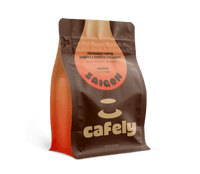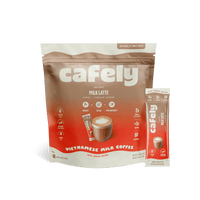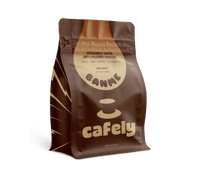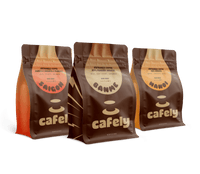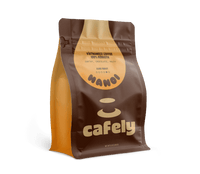If you’re looking for a coffee with a flavor profile that’s different from your standard 100% arabica or robusta, you might start looking into interesting variations. Catimor is a genetic combination of these two popular coffee varieties.
A group of agricultural scientists from Portugal created this new coffee in 1957 in an effort to make a coffee plant that produced high yields and wasn’t susceptible to leaf rust and other pests [1].
There are now quite a few different kinds of Catimor coffees across the planet, but most are in Central America, Africa, and Asia.
So, what makes Catimor coffee different? Let's take a look under the hood of this specialty coffee variety.
What Is Catimor Coffee?

So, Catimor coffee is made up of a mix of Timor and Caturra coffees. Timor is mostly robusta coffee and is resistant to pests and leaf rust — one of the main reasons Catimor was developed in the first place.
Caturra, on the other hand, is another variety of Coffea arabica. It’s a highly productive variety that has great yield, which is needed for high production values. In fact, it’s all over Central America and is one of the most important coffees in the region both economically and in terms of creating new blends.
Related: What is Liberica Coffee?
What Does Catimor Coffee Taste Like?
That leads one to wonder — what does Catimor coffee taste like?
As a blend of robusta and arabica, there is a complex mix of flavors that include:
- Ripe berries
- Herbal notes
- Nutty vibes
- Cherry
- Acidity
- Sweetness
With this complex blend of flavors, it’s a crowd-pleasing type of coffee that has the best of both worlds. It definitely leans more into the world of arabica with the fruity notes, but those nutty undertones are all robusta.
Related: What are the Differences Between Robusta and Arabica Coffees?
Who Created the Catimor Coffee Varietal?

Catimor was created by Portuguese scientists in the late 1950s to help save the coffee industry in Central America. At the time, coffee leaf rust was killing off many people’s livelihoods and threatening the production of coffee as a whole in the entire region.
Using the robusta-backed Timor as a base, they were able to develop a pest and rust-resistant coffee that wasn’t going to be plagued like the other varieties. Adding the Caturra was predominantly for taste and getting those much-needed high yields.
Related: What’s the History of Vietnamese Coffee?
Where Can You Find Catimor Coffee?
You can find Catimor in Central, and South America, Africa, and Asia but there are other versions in different places. For instance, Catimor 129 is found mostly in Zambia, Malawi, and Zimbabwe in Southern Africa. On the other hand, Oro Azteca, which is a different version of Catimor, was developed in Mexico and is popular in Central America.
With the spread of different varieties around the world, it's common to find Catimor in Asian coffee hotspots like India and Vietnam. The combination of a pest-resistant robusta base with a more commercial and fruity arabica flavor profile is an appealing prospect to a lot of coffee farmers.
Related: Vietnamese Weasel Coffee
FAQs About Catimor Coffee
Now you know what Catimor coffee is and how it’s different from a lot of other coffee types, it’s time to finish off with some frequently asked questions.
1. Are Catimor & Caturra coffee the same?
No, Catimor and Caturra Coffee are not the same. Caturra is the parent coffee of Catimor. By blending the arabica-based Caturra with the robusta-based Timor, you get a beautifully delicious and hardy Catimor coffee.
You can’t have Catimor without Caturra, but you can have Caturra without Catimor, as it’s the parent coffee of many other blends.
Cafely has a great collection of arabica and robusta beans that would surely give you a great experience.
2. Is Catimor made from robusta or arabica?
Catimor coffee was bred from both robusta and arabica coffees with the goal of acquiring the best properties from both types. It utilizes the hardiness and pest resistance from the robusta side of the family and takes the smoother and less bitter flavor profile from the arabica side.
You could also try our Da Nang Coffee which is a blend of arabica and robusta.
3. Why is Catimor coffee controversial?
While many producers and coffee brands love Catimor, it’s not without its downsides. Many coffee producers report that production of Catimor drops off after around 10 years — that’s really short for a coffee plant. It’s thought that this happens because the plant can’t maintain such a high and intense yield past a decade.
4. Can you get Vietnamese Catimor coffee?
Yes, some say that the best Catimor coffee in the world comes from Vietnam. The volcanic soil and tropical conditions of the Central Highlands are perfect for Vietnamese-grown Catimor and robusta varieties, which should come as no surprise considering that 40% of the world’s robusta coffee also comes from Vietnam.
5. Is Catimor coffee healthy?
Catimor coffee has been associated with health benefits. Several studies have found beneficial magnesium, potassium, niacin, and vitamin E in coffee [2], but additional studies have found a change in the antioxidant levels throughout the roasting process in Catimor specifically [3]. While this doesn’t make Catimor coffee healthy per se, it does have additional health benefits.
Related: Is Vietnamese Coffee Healthy?
References
- Talhinhas, P., Batista, D., Diniz, I., Vieira, A., Silva, D. N., Loureiro, A., Tavares, S., Pereira, A. P., Azinheira, H. G., Guerra-Guimarães, L., Várzea, V., & Silva, M. D. C. (2017). The coffee leaf rust pathogen Hemileia vastatrix: one and a half centuries around the tropics. Molecular plant pathology, 18(8), 1039–1051.
- Singh, V., Singh, V., & Verma, D. (2017). Processing Technology and Potential Health Benefits of Coffee.
- Mestanza, M., Mori-Culqui, P. L., & Chavez, S. G. (2023). Changes of polyphenols and antioxidants of arabica coffee varieties during roasting. Frontiers in nutrition, 10, 1078701.
